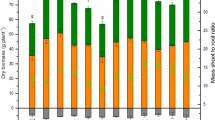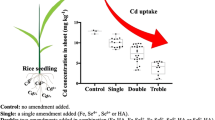Abstract
Chemical amendments can enhance heavy metal phytoextraction by increasing metal bioavailability for plant root uptake and translocation to shoots, and by improving plant growth. This study assessed the effect of various amendments on plant growth and metal uptake over a 30-day period. An aminopolycarboxylic acid (EDDS), amino acid (histidine), organic acid (citric acid), biosurfactant (rhamnolipid), and inorganic ligand (sulfate) were applied as amendments individually or in combination to hydroponically grown ryegrass (Lolium perenne cv. SR4500) in the presence of a metal (Cu, Cd or Pb). EDDS (1 mM) was the most effective amendment (individually and in combinations) for enhancing Cu and Pb uptake to shoot tissue, while histidine was beneficial for increasing both Cu and Cd uptake. Individual treatments of citric acid, rhamnolipid and sulfate moderately enhanced shoot concentrations of Cu and Cd only. The combination of EDDS, rhamnolipid and citric acid resulted in the highest shoot metal levels, but also caused severe phytotoxicity. Translocation to shoot tissue was generally greater for amendments with higher affinity for the metal of interest, and metal mobility appeared to be influenced by speciation. Due to potential toxicity, amendment combinations may be more effective when applied shortly before harvesting.



Similar content being viewed by others
References
Alkorta I, Hernandez-Allica J, Becerril JM, Amezaga I, Albizu I, Onaindia M, Garbisu C (2004) Chelate-enhanced phytoremediation of soils polluted with heavy metals. Environ Sci Biotechnol 3:55–70
Bidar G, Pruvot C, Garçon G, Verdin A, Shirali P, Douay F (2009) Seasonal and annual variations of metal uptake, bioaccumulation, and toxicity in Trifolium repens and Lolium perenne growing in a heavy metal-contaminated field. Environ Sci Pollut Res 16(1):42–53
Blaylock MJ, Dushenkov S, Zakharova O, Gussman C, Kapulnik Y, Ensley BD, Salt DE, Raskin I (1997) Enhanced accumulation of Pb in Indian mustard by soil-applied chelating agents. Environ Sci Technol 31:860–865
Boussama N, Ouariti O, Ghorbal MH (1999) Changes in growth and nitrogen assimilation in barley seedlings under cadmium stress. J Plant Nutr 22:731–752
Callahan DL, Baker AJM, Kolev SD, Wedd AG (2005) Metal ion ligands in hyperaccumulating plants. J Biol Inorg Chem 11:2–12
Chandra Sekhar K, Kamala CT, Chary NS, Balaram V, Garcia G (2005) Potential of Hemidesmus indicus for phytoextraction of lead from industrially contaminated soils. Chemosphere 58:507–514
Chen YX, Lin Q, Luo YM, He YF, Zhen SJ, Yu YL, Tian GM, Wong MH (2003) The role of citric acid on the phytoremediation of heavy metal contaminated soil. Chemosphere 50:807–811
Chiu KK, Ye ZH, Wong MH (2005) Enhanced uptake of As, Zn, and Cu by Vetiveria zizanioides and Zea mays using chelating agents. Chemosphere 60:1365–1375
Degryse F, Smolders E, Merckx R (2006) Labile Cd complexes increase Cd availability to plants. Environ Sci Technol 40:830–836
di Sanita TL, Gabbrielli R (1999) Response to cadmium in higher plants. Environ Exp Bot 41:105–130
Dushenkov V, Kumar PBAN, Motto H, Raskin I (1995) Rhizofiltration: the use of plants to remove heavy metals from aqueous streams. Environ Sci Technol 29:1239–1245
Evangelou MWH, Ebel M, Schaeffer A (2006) Evaluation of the effect of small organic acids on phytoextraction of Cu and Pb from soil with tobacco Nicotiana tabacum. Chemosphere 63:996–1004
Evangelou MWH, Ebel M, Schaeffer A (2007) Chelate assisted phytoextraction of heavy metals from soil. effect, mechanism, toxicity, and fate of chelating agents. Chemosphere 68:989–1003
Grčman H, Vodnik D, Velikonja-Bolta S, Lestan D (2003) Ethylenediaminedissuccinate as a new chelate for environmentally safe enhanced lead phytoextraction. J Environ Qual 32:500–506
Hart JJ, Welch RM, Norvell WA, Sullivan LA, Kochian LV (1998) Characterization of cadmium binding, uptake, and translocation in intact seedlings of bread and durum wheat cultivars. Plant Physiol 116:1413–1420
Jeneil Biosurfactant Co. LLC (2001) Material safety data sheet for JBR425
Johnson A, Gunawardana B, Singhal N (2009) Amendments for enhancing copper uptake by Brassica juncea and Lolium perenne from solution. Int J Phytoremediat 11:215–234
Jones D (1998) Organic acids in the rhizosphere - a critical review. Plant Soil 205:24–44
Jordan FL, Robin-Abbott M, Maier RM, Glenn EP (2002) A comparison of chelator-facilitated metal uptake by a halophyte and a glycophyte. Environ Toxicol Chem 21:2698–2704
Kabata-Pendias A, Pendias H (2001) Trace elements in soils and plants. CRC Press LLC, Boca Raton
Kayser A, Wenger K, Keller A, Attinger W, Felix HR, Gupta SK, Schulin R (2000) Enhancement of phytoextraction of Zn, Cd, and Cu from calcareous soil: the use of NTA and sulfur amendments. Environ Sci Technol 34:1778–1783
Kerkeb L, Kramer U (2003) The role of free histidine in xylem loading of nickel in Alyssum lesbiacum and Brassica juncea. J Plant Physiol 131:716–724
Kos B, Lestan D (2003) Induced phytoextraction/soil washing of lead using biodegradable chelate and permeable barriers. Environ Sci Technol 37:624–629
Kos B, Lestan D (2004) Chelator induced phytoextraction and in situ soil washing of Cu. Environ Pollut 132:333–339
Kramer U, Cotter-Howells JD, Charnock JM, Baker AJM, Smith JAC (1996) Free histidine as a metal chelator in plants that accumulate nickel. Nature 379:635–638
Kulli B, Balmer M, Krebs R, Lothenbach B, Geiger G, Schulin R (1999) The influence of nitrilotriacetate on heavy metal uptake of lettuce and ryegrass. J Environ Qual 28:1699–1705
Kvesitadze G, Khatisashvili G, Sadunishvili T, Ramsden JJ (2005) Biochemical mechanisms of detoxification in higher plants. Springer, Heidelberg
Lasat MM (2000) Phytoextraction of metals from contaminated soil: a review of plant/soil/metal interaction and assessment of pertinent agronomic issues. J Hazard Subst Res 2:1–25
Lepp NW (2005) Copper. In: Shtangeeva I (ed) Trace and ultratrace elements in plants and soil. WIT, Southampton
Lombi E, Zhao FJ, Dunham SJ, McGrath SP (2001) Phytoremediation of heavy metal-contaminated soils: natural hyperaccumulation versus chemically enhanced phytoextraction. J Environ Qual 30:1919–1926
Luo C, Shen Z, Li X (2005) Enhanced phytoextraction of Cu, Pb, Zn and Cd with EDTA and EDDS. Chemosphere 59:1–11
Luo C, Shen Z, Li X, Baker AJM (2006a) Enhanced phytoextraction of Pb and other metals from artificially contaminated soils through the combined application of EDTA and EDDS. Chemosphere 63:1773–1784
Luo C, Shen Z, Luo L, Li X (2006b) EDDS and EDTA-enhanced phytoextraction of metals from artificially contaminated soil and residual effects of chelant compounds. Environ Pollut 144:862–871
Martell AE, Smith RM (1974) Critical stability constants, vol 1–6. Plenum, New York
McBride M (1994) Environmental chemistry of soils. Oxford University Press, New York
McGrath SP, Chaudri AM, Giller KE (1995) Long-term effects of metals in sewage sludge on soils, microorganisms and plants. Indian J Microbiol 14:94–104
Mulligan CN (2005) Environmental applications for biosurfactants. Environ Pollut 133:183–198
Mulligan CN (2007) Rhamnolipid biosurfactants: solubility and environmental issues. Elsevier B.V.
Mulligan CN, Yong RN, Gibbs BF (2001) Remediation technologies for metal-contaminated soils and groundwater: an evaluation. Eng Geol 60:193–207
Neilson JW, Artiola JF, Maier RM (2003) Characterization of lead removal from contaminated soils by nontoxic soil-washing agents. J Environ Qual 32:899–908
Ochoa-Loza FJ, Artiola JF, Maier RM (2001) Stability constants for the complexation of various metals with a rhamnolipid biosurfactant. J Environ Qual 30:479–485
Oviedo C, Rodríguez J (2003) EDTA: the chelating agent under environmental scrutiny. Quim Nova 26:901–905
Pahlsson AMB (1989) Toxicity of heavy metals (Zn, Cu, Cd, Pb) to vascular plants- a literature review. Water Air Soil Poll 47:287–319
Paz-Alberto AM, Sigua GC, Baui BG, Prudente JA (2007) Phytoextraction of lead-contaminated soil using Vetivergrass (Vetiveria zizanioides L.), Cogongrass (Imperata cylindrica L.) and Carabaograss (Paspalum conjugatum L.). Environ Sci Pollut Res 14(7):498–504
Pilon-Smits E (2005) Phytoremediation. Annu Rev Plant Biol 56:15–39
Puschenreiter M, Stoger G, Lombi E, Horak O, Wenzel WW (2001) Phytoextraction of heavy metal contaminated soils with Thlaspi goesingense and Amaranthus hybridus: rhizosphere manipulation using EDTA and ammonium sulfate. J Plant Nutr Soil Sci 164:615–621
Quartacci MF, Argilla A, Baker AJM, Navari-Izzo F (2006) Phytoextraction of metals from a multiply contaminated soil by Indian mustard. Chemosphere 63:918–925
Quartacci MF, Irtelli B, Baker AJM, Navari-Izzo F (2007) The use of NTA and EDDS for enhanced phytoextraction of metals from a multiply contaminated soil by Brassica carinata. Chemosphere 68:1920–1928
Romkens P, Bouwman L, Japenga J, Draaisma C (2002) Potentials and drawbacks of chelate-enhanced phytoremediation of soils. Environ Pollut 116:109–121
Rothery E (1988) Analytical methods for graphite tube atomizers. Varian Australia Pty Ltd, Mulgrave
Salt DE, Blaylock M, Kumar PBAN, Dushenkov V, Ensley BD, Chet I, Raskin I (1995) Phytoremediation: a novel strategy for the removal of toxic metals from the environment using plants. Biotechnology 13:468–478
Salt DE, Smith RD, Raskin I (1998) Phytoremediation. Annu Rev Plant Physiol Plant Mol Biol 49:643–668
Schaider LA, Parker DR, Sedlak DL (2006) Uptake of EDTA-complexed Pb, Cd and Fe by solution and sand-cultured Brassica juncea. Plant Soil 286:377–391
Schmidt U (2003) Enhancing phytoextraction: the effect of chemical soil manipulation on mobility, plant accumulation, and leaching of heavy metals. J Environ Qual 32:1939–1954
Singer AC, Bell T, Heywood CA, Smith JAC, Thompson IP (2007) Phytoremediation of mixed-contaminated soil using the hyperaccumulator plant Alyssum lesbiacum: evidence of histidine as a measure of phytoextractable nickel. Environ Pollut 147:74–82
Stacey S, McLaughlin M, Cakmak I, Hettiarachchi G, Scheckel K, Karkkainen M (2008) Root uptake of lipophilic zinc-rhamnolipid complexes. J Agric Food Chem 56:2112–2117
Tandy S, Schulin R, Nowack B (2006) The influence of EDDS on the uptake of heavy metals in hydroponically grown sunflowers. Chemosphere 62:1454–1463
Torrens J, Herman DC, Miller-Maier RM (1998) Biosurfactant (rhamnolipid) sorption and the impact on rhamnolipid-facilitated removal of cadmium from various soils under saturated flow conditions. Environ Sci Technol 32:776–781
Turgut C, Pepe MK, Cutright TJ (2004) The effect of EDTA and citric acid on phytoremediation of Cd, Cr, and Ni from soil using Helianthus annuus. Environ Pollut 131:147–154
Van Engelen DL, Sharpe-Pedler RC, Moorhead KK (2007) Effect of chelating agents and solubility of cadmium complexes on uptake from soil by Brassica juncea. Chemosphere 68:401–408
Vassil AD, Kapulnik Y, Raskin I, Salt DE (1998) The role of EDTA in lead transport and accumulation by Indian mustard. Plant Physiol 117:447–453
Vassilev A, Vangronsveld J, Yordanov I (2002) Cadmium phytoextraction: present state, biological background and research needs. Bulg J Plant Physiol 28:68–95
Welch RM, Norvell WA (Eds.) (1999) Mechnisms of cadmium uptake, translocation, and deposition in plants. Kluwer Academic Publishers
Wenger K, Gupta SK, Furrer G, Schulin R (2003) Heavy metals in the environment: the role of nitrilotriacetate in copper uptake by tobacco. J Environ Qual 32:1669–1676
Wu FB, Dong J, Qian QQ, Zhang GP (2005) Subcellular distribution and chemical form of Cd and Cd-Zn interaction in different barley genotypes. Chemosphere 60:1437–1446
Wu QT, Wei ZB, Ouyang Y (2007) Phytoextraction of metal-contaminated soil by Sedum alfredii H: effects of chelator and co-planting. Water Air Soil Poll 180:131–139
Yruela I (2005) Copper in plants. Braz J Plant Physiol 17:145–156
Author information
Authors and Affiliations
Corresponding author
Additional information
Responsible Editor: Fangjie J. Zhao.
Electronic supplementary material
Below is the link to the electronic supplementary material.
Table A
Effects of amendments and metal treatments on root and shoot biomass after 30 days. Values represent the average of three replicates ± standard deviation (DOC 46 kb)
Rights and permissions
About this article
Cite this article
Gunawardana, B., Singhal, N. & Johnson, A. Amendments and their combined application for enhanced copper, cadmium, lead uptake by Lolium perenne . Plant Soil 329, 283–294 (2010). https://doi.org/10.1007/s11104-009-0153-4
Received:
Accepted:
Published:
Issue Date:
DOI: https://doi.org/10.1007/s11104-009-0153-4




